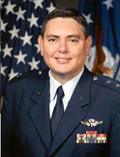|
Splash Page | Alumni profile | Notables

Out of your mind
When
fighter pilots
began reporting
out-of-body
experiences
during G-Force
blackouts, this Horned Frog
doctor tracked
down the cause.

By Mark Wright '07 (MS)
 Dr. James Whinnery '72 doesn't claim to understand what happens to people when they die and he isn't trying to find out. Yet the retired Air Force major general from Amarillo is widely recognized as a leading authority on out-of-body experiences. Dr. James Whinnery '72 doesn't claim to understand what happens to people when they die and he isn't trying to find out. Yet the retired Air Force major general from Amarillo is widely recognized as a leading authority on out-of-body experiences.
It happened quite by accident.
Whinnery, who specialized in aerospace medicine during his 30 years in the service, was charged with answering a question of practical concern to the Air Force: Why were so many pilots blacking out in the cockpits of high-powered F-15 and F-16 jets?
"The research was a very applied medical research to help fighter pilots fly to the full potential of their aircraft," said Whinnery, who earned a bachelor's in chemistry from West Texas State University (now West Texas A&M) and two advanced degrees in chemistry at TCU before pursuing a medical degree from the University of Texas Medical Branch in Galveston.
Technological developments in the 1970s enhanced the capabilities of military aircraft but pushed the human body to the limit. It had been the Air Force's policy to ground any pilot who suffered loss of consciousness while flying. But Whinnery and his fellow researchers discovered that perfectly healthy pilots were blacking out. It turned out the rapid acceleration of the jets was to blame.
"The aircraft were faster, but we had the same tolerance," Whinnery said. "The aircraft was tougher than the human being."
In 1978, Whinnery, then a flight surgeon at Brooks Air Force Base in San Antonio, began to study the effects on pilots of G-forces Ð a unit measuring the force of gravity exerted during rapid acceleration. He discovered that a healthy pilot could function normally when exposed to an average of 2.5 Gs to 3 Gs. But the pilots of fighter jets were regularly being exposed to up to 9 Gs.
Whinnery, who in 1983 became chief of the acceleration effects laboratory at Brooks, undertook a long-term study of the phenomenon, which became known as G-induced loss of consciousness, or G-LOC.
Whinnery and his researchers placed pilots in gravitational centrifuges Ð similar to the much smaller equipment used to spin a vial of blood on a desktop Ð and examined how the G-forces affected their brains and bodies.
The scientists learned that during periods of rapid acceleration, a subject's blood flows into his lower extremities and away from his brain. The resulting lack of oxygen leads to a period of unconsciousness that lasts on average 12 seconds, followed by another 12 seconds of disorientation.
"That's 24 seconds that you don't have control over your aircraft," Whinnery said. "Twenty-four seconds was average. Some people were out a lot longer."
They also asked the pilots to describe the symptoms they experienced while in the centrifuge or in flight. A clear pattern emerged. The first thing they experienced was tunnel vision, which results from a lack of blood flow to the eyes and is a precursor to a blackout. Then, while unconscious, many of the subjects experienced short, vivid dreams, or dreamlets. The dreams were often about past experiences or family and friends.
In addition to dreamlets, a significant number of pilots reported having out-of-body experiences. The subjects described the sensation of floating above their planes and looking down at their bodies. Sometimes the dreamlets and out-of-body experiences were accompanied by feelings of euphoria and warmth. Some subjects said they saw a bright light.
Surprised by his findings, Whinnery sought out scientific literature about reported out-of-body experiences. He found that out-of-body experiences were reported by cardiac arrest patients who were resuscitated. The pilots and heart attack victims had something in common: a momentary loss of blood to the brain.
"I didn't know whether we ought to talk about this," Whinnery said. "All we were doing is reporting what we had. It made sense to us. You're doing the same thing to the body in both cases, essentially."
Although Whinnery was convinced that his findings should be reported, selling Air Force officials on the validity of his research was another matter.
"We were concerned about how our findings would be received," he said. "It didn't go over really well in the Air Force. They weren't interested in talking about life after death."
Neither was Whinnery. After studying more than 700 cases of G-LOC, Whinnery has gained new insights into how the brain works. He discovered that, essentially, blacking out is like unplugging a computer and then plugging it back in. The computer doesn't come back on all at once; it must reboot. Likewise, the dreamlets and out-of-body experiences seem to have been a result of the computers in our heads coming back online.
"We believe the short dreamlets and out-of-body experiences occur from the transition to consciousness," Whinnery said.
Whinnery's research, which was published in several prominent scientific and medical journals, led the Air Force to reconsider its policies about pilots suffering blackouts. Now, losing consciousness is not usually grounds for disqualification, he said. He also contributed to the safety of fighter pilots by helping develop redesigned cockpits and anti-G suits.
He continues to make the skies safer. Since 1999, Whinnery has been the manager of the aerospace medical research division of the Federal Aviation Administration's Civil Aerospace Medical Institute in Oklahoma City. Anytime a civilian flight crashes, Whinnery's team takes forensic toxicology samples to see if the pilots or passengers had drugs in their system or if a fire had occurred onboard.
"It's not just the American Airlines flights, it's the guy in the Cessna," Whinnery said. "There's a lot more people killed in private flying than with commercial flights."
Whinnery's team also studies crash dynamics and airline cabin safety and monitors levels of radiation in the atmosphere, which can be elevated greatly by solar flares.
"Anytime there's a human flying in the U.S., we worry about the human's safety," said Whinnery, who retired from the Air Force in 2002.
Outside the lab, Whinnery is an educator. He has taught courses at Brooks Air Force Base, the Air Force Academy and Drexel University and in the late '90s served as the head of the department of mathematics, physical sciences and engineering at West Texas A&M. He also served as a teaching fellow at TCU.
Of all the stops along the way, his four years at TCU were among his favorite, Whinnery said. He credits his TCU professors with teaching him how to think critically. While in Fort Worth, he also learned to dislike the raucous fans of the University of Arkansas, who turned out in droves whenever the former Southwest Conference rival Razorbacks and Horned Frogs played at Amon Carter Stadium.
"TCU was the linchpin in my development," Whinnery said. "School can teach you a lot of stuff in terms of facts, but what they tried to do is challenge you to think. It's unique to be able to use your head and apply the knowledge you get."
Whinnery, the son of a West Texas chemical engineer, said he kind of got sidetracked by aerospace medicine. He certainly never planned to study out-of-body experiences Ð research that has been cited by neuroscientists seeking to answer questions about the human body and by bloggers and radio hosts obsessed with tales of near-death experiences.
"I'm just a straight-laced physical chemist and physician," he said. "I'm open for anything if you can prove it."

More at www.near-death.com/experiences/triggers06.html
Comment at tcumagazine@tcu.edu. |



